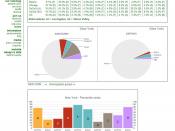It is vital that the judicial appointment process identifies the most talented people for appointment, irrespective of their professional or social background. Women are under-represented in the legal professions and there are arguments to suggest this is due to discrimination. This discrimination against women has become known as 'the glass ceiling' and it has been debated whether it is 'cracking' or remains in tact.
Nearly half of new barristers and more than half of new solicitors are female, yet evidence shows they will achieve subordinate careers to the men they qualify with. An independent study in 1992 called 'Without prejudice' believed there to be institutional discrimination at every stage of barristers' careers. Women found it harder to find pupillages and permanent places in chambers, were asked questions about marriage and children, earned less than men and were less able to find work in their area of choice. Women were disproportionately likely to miss out on training contracts according to the Law Society 1999, and this bias is reinforced at higher levels of the profession.
There are very few women in the higher levels of the legal profession; women solicitors are generally in junior positions even though a third of practising solicitors are women. Even the most senior and successful women barristers were concentrated in the less prestigious and lower paid areas of family and criminal law. Female directors tend to be in female-dominated areas like marketing and personnel. Women also only make up 6% of QC's, which has outraged The Association of Women Barristers who accused leaders of the barristers' profession of running an 'old boys club'. They have called for either the abolition of QC's or a transfer of the power of patronage from the Lord Chancellor to "an autonomous committee of senior judges and senior users of advocacy...


